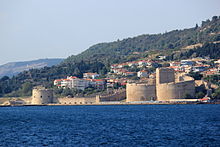Dardanelles
![]()
Hellespont is a redirect to this article. For other meanings, see Hellespont (disambiguation).
The Dardanelles (Modern Greek Δαρδανέλλια Dardanellia, also Δαρδανέλια Dardanelia (n. pl.), Turkish Çanakkale boğazı) is a strait in the Mediterranean Sea, between the Aegean and the Sea of Marmara, belonging to Turkey. In ancient times, this strait was called Hellespont (IPA: [hɛlɛsˈpɔnt], ![]() ), named after Helle, a figure from Greek mythology, as well as ancient Greek πόντος pontos "sea", "high sea".
), named after Helle, a figure from Greek mythology, as well as ancient Greek πόντος pontos "sea", "high sea".
Geography
The Dardanelles are located between the European peninsula of Gallipoli and northwestern Anatolia, which belongs to Asia Minor, they are the southwesternmost part of the Inner Eurasian border. The name comes from Dardanos, a settlement that was located near Troy.
This strait connects the Aegean Sea with the Sea of Marmara and, via the adjacent Bosporus, with the Black Sea. The Dardanelles are about 65 kilometres long and between 1.3 and 6 kilometres wide, with an average depth of 50 metres. On the surface, a current flows from the Sea of Marmara to the Mediterranean Sea, while an undercurrent flows in the opposite direction, due to the almost double salinity of the Mediterranean Sea compared to the Black Sea.
On the Asian coast of the Dardanelles is the port city of Çanakkale. The Çanakkale 1915 Bridge between Lapseki and Gelibolu is under construction. With 3623 meters it will be the longest bridge in Turkey. The target completion date is 2023.
History
In Greek mythology it is said that Achilles was buried in the waters of the Hellespont after his death in the Trojan War. According to tradition, the ancient places of Sestos on the European shore and Abydos on the Asia Minor shore were the setting for the story of Hero and Leander.
In the Second Persian War, the Persian king Xerxes crossed the Hellespont during his campaign against Greece in about 480 BC with two ship bridges, each consisting of over 300 ships and said to have had a temporary opening for smaller ships. Alexander the Great crossed the Hellespont in 334 BC with an army of about 35,000 Macedonians and Greeks at the beginning of his Persian campaign.
The Peloponnesian War saw several significant battles on the Hellespont, including the Battle of Cyzicus in 410 BC and the Battle of Aigospotamoi, the decisive defeat of the Athenians in 405 BC.
In 1656 there was the Battle of the Dardanelles, one of the naval engagements and battles fought by the fleets of the Republic of Venice and the Ottoman Empire for supremacy in the eastern Mediterranean.
Under the Dardanelles Treaty of 1841, only Turkish warships were allowed to pass through this strait. In the run-up to the First World War, the Dardanelles played a significant role: Russia was concerned that the German Empire would gain too much influence over the region. For this reason, Russia put pressure on the Entente to resist the German Empire in establishing a military mission. During World War I, the Dardanelles were the scene of the Battle of Gallipoli due to their strategic location, with heavy losses on both sides. Since 1936, the Treaty of Montreux has regulated the rights of passage.

Kilitbahir Fortress at the narrowest point of the Dardanelles near Eceabat
Search within the encyclopedia